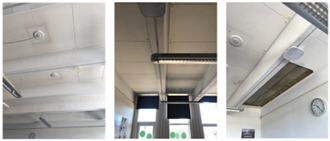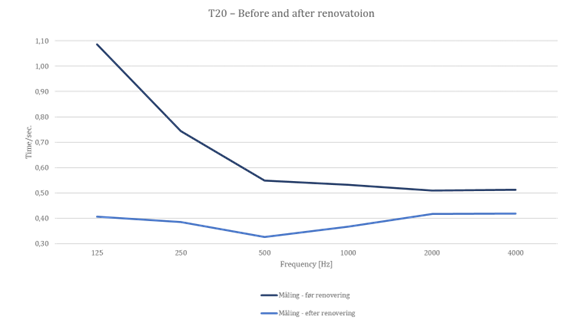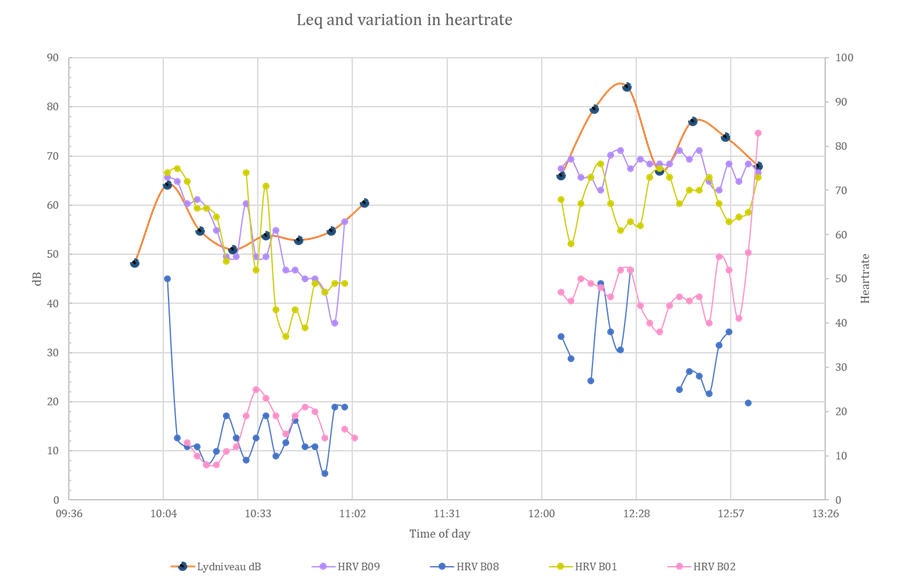
For many years, research has shown that good room acoustics is crucial in learning environments and the discussion is no longer whether good room acoustics is to be prioritized or not but rather what indicators should reach what levels.
Rasmussen et al [1] give an overview of the trend in reverberation time criteria for classrooms in the Nordic countries and they describe the trend to be clear: Shorter RT is assumed to be better. In Denmark RT in classrooms for traditional teaching has to reach ≤ 0.6 sec. and group rooms and rooms for students with special needs have to reach ≤ 0.4 sec. according to the Danish Building Regulations [2]. Despite these relatively short RTs the end users – both children and teachers – still complain about high noise levels and poor sound environments [3, 4].
Early and late reflections
Ever since the investigations of Joseph Henry, [5, 6] acousticians have discussed the relation between early and late reflections. As the teaching and learning styles develop at the same time as children with special needs get included in the traditional classroom it seems as if we must consider both the patterns of the reflections and the sound levels to be just as important as RT.
The cognitive demands on children have never been higher and the children of today need to manage multiple tasks such as writing, reading, controlling modern technology, engaging in discussions with classmates, and listening to the teacher’s voice while simultaneously the children need to ignore competing background noise from the classroom and the hallway. This means a significant load on their cognitive resources [7].
Bradley and Sato [8] commented 20 years ago that ‘A lack of appreciation of the importance of early reflections is no doubt responsible for some recommendations for very short reverberation times for rooms for speech’ and research has shown some cases of problems with speakers comfort when reverberation time gets too short, and it is interesting to learn if a more detailed overview of several descriptors would secure optimum room acoustics in schools.

Classroom study at Stilling School, Denmark
Three engineering students from Århus University in Denmark, Emma Sundgaard Poulsen, Esther Kerrn-Jespersen, and Rasmus Estrup Christensen recently conducted research on whether the theoretical research on the importance of more room acoustic descriptors in learning environments will be supported by practical findings or not.
Their project included investigations of the acoustic indoor climate in a classroom through a comparative study prior to and post renovations. Parameters such as reverberation time, speech clarity, and speech transmission index were measured prior to and post the renovation and compared against the Danish building regulations and industry standards. Furthermore, the students investigated calculation methods for determining reverberation time (findings are not included in this article), and finally, the correlation between sound pressure levels and stress was explored.
In short, they investigated the sound environment in the classroom before and after installing new sound-absorbing ceilings and new wall panels.
NB. All tables, figures, photos, and data below are done and owned by Emma Sundgaard Poulsen, Esther Kerrn-Jespersen, and Rasmus Estrup Christensen.


Results




The project aimed to include data on students’ heart rates before and after the renovation – but due to complex rules on GDPR and children’s privacy, the study included a small stress test study done at the university with university students instead. They were exposed to different sound pressure levels while doing normal tasks. One hour with ‘normal’ background sound levels – one hour with increased background sound levels.

Top 3 takeaways:
- There was a significant correlation between high sound pressure levels and stress among students and teachers.
- A reverberation time of 0,4 seconds is favorable for both neurotypical and neurodiverse students in primary schools.
- Reverberation time, by itself, does not provide an accurate assessment of classroom acoustics. It is necessary to examine parameters such as Speech Transmission Index and speech clarity to ensure optimal communication and comprehensibility.

References:
[1] B. Rasmussen, J. Brunskog, D. Hoffmeyer, Reverberation time in class rooms – Comparison of regulations and classifications criteria in the Nordic countries, Proc. BNAM, Odense, Denmark, 2012
[2] Building Regulations 2010, Danish Enterprise and Construction Authority, Danish Ministry of Economic and Business Affairs. http://erhvervsstyrelsen.dk/file/155699/BR10_english.pdf
[3] The National Research Centre for the Working Environment, Arbejdsmiljø og helbred i Danmark 2012, http://www.arbejdsmiljoforskning.dk/~/media/Boeger-og-rapporter/Arbejdsmiljoe-og-helbred-i-Danmark2012-Netversion-Juni2013.pdf
[4] Danish Centre of Educational Environment, DCUM, Indeklima og fagligt udbytte, 2013, http://dcum.dk/indeklima-og-fagligt-udbytte-rapport
[5] Wilbert F. Snyder, Acoustical Investigations of Joseph Henry as Viewed in 1940, J. Acoust. Soc. Am. 12, 464 ff, 1941
[6] Emily Ann Thompson, The Soundscape Of Modernity: Architectural Acoustics And The Culture Of Listening In America, 2002
[7] Howard et al, Listening effort at signal-to-noise ratios that are typical of the school classroom, Int. J. Audiol. 48 (12):928ff, 210
[8] J. S. Bradley and H. Sato, On the importance of early reflections for speech in rooms, J. Acoust. Soc. Am. 113, 2003

